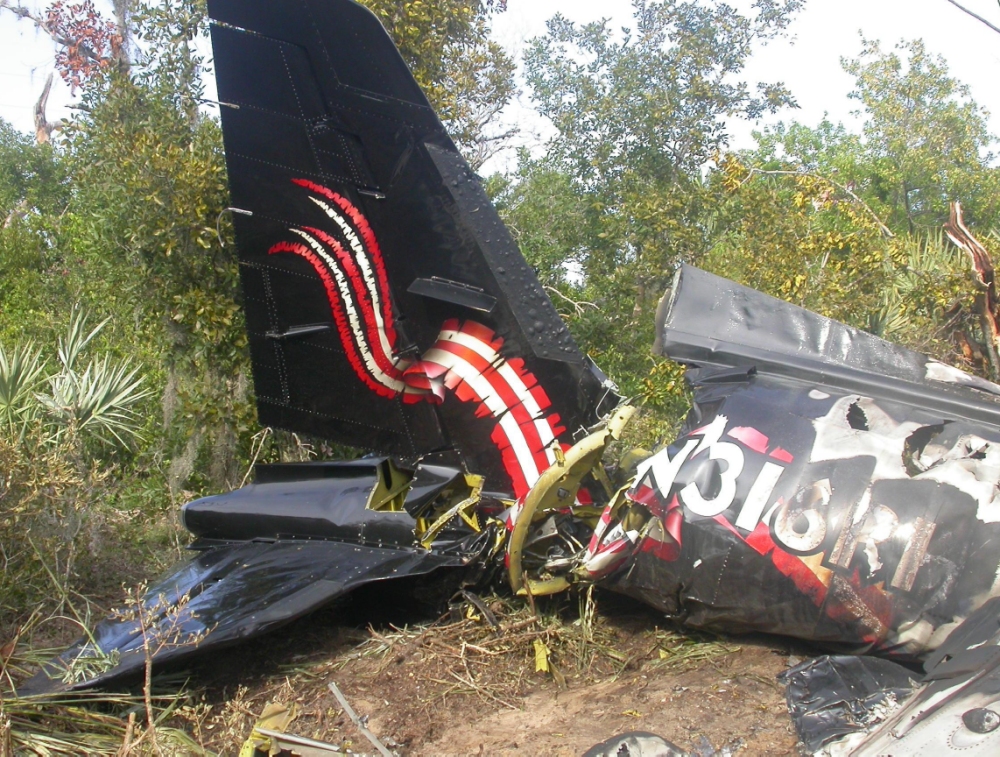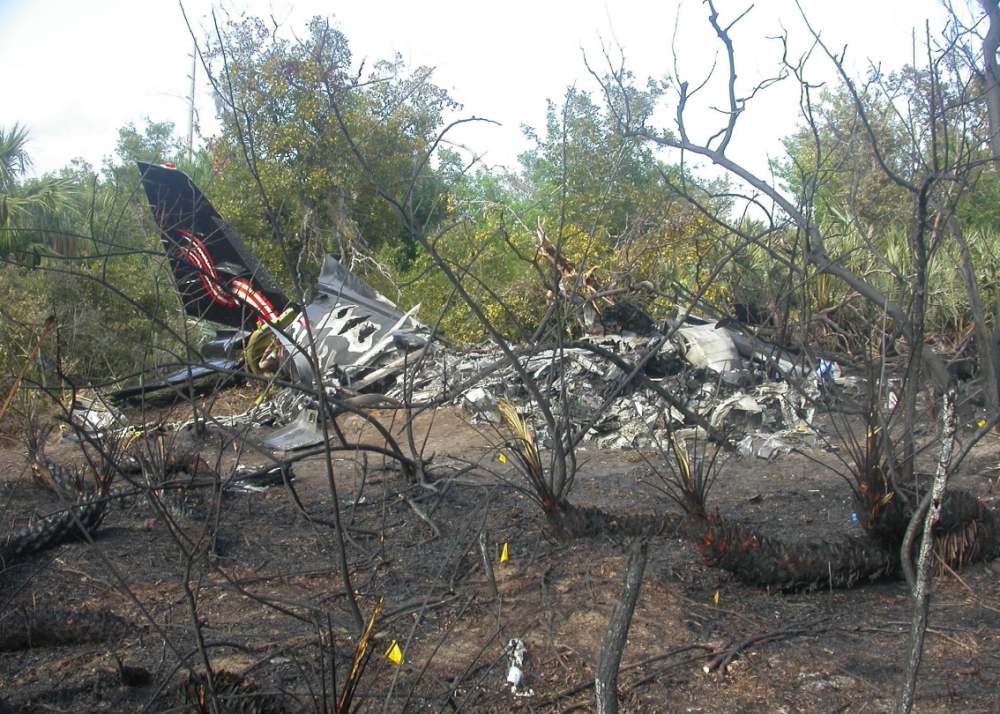
ASN Wikibase Occurrence # 44093
This information is added by users of ASN. Neither ASN nor the Flight Safety Foundation are responsible for the completeness or correctness of this information.
If you feel this information is incomplete or incorrect, you can submit corrected information.
| Date: | Sunday 25 June 2006 |
| Time: | 12:24 |
| Type: |  Mitsubishi MU-2B-60 Marquise |
| Owner/operator: | Flyin Cloud LLC |
| Registration: | N316PR |
| MSN: | 761SA |
| Year of manufacture: | 1980 |
| Total airframe hrs: | 4073 hours |
| Engine model: | Honeywell TPE-331-10 |
| Fatalities: | Fatalities: 1 / Occupants: 1 |
| Aircraft damage: | Destroyed |
| Category: | Accident |
| Location: | Fort Pierce, FL -
 United States of America United States of America
|
| Phase: | Take off |
| Nature: | Ferry/positioning |
| Departure airport: | Fort Pierce, FL (FPR) |
| Murfreesboro, TN (MBT) | |
| Investigating agency: | NTSB |
| Confidence Rating: |
Witnesses stated that they observed the twin-engine airplane roll into a steep right bank and enter a spin at a low altitude (less than 700 feet) during the initial climb. The airplane then descended and impacted terrain about 1.5 miles from the end of the departure runway. Some witnesses reported hearing an unusual engine noise just before the airplane began to roll and spin. Day visual meteorological conditions prevailed.
Examination of the right engine revealed that the ring gear support of the engine/propeller gearbox had fractured in flight due to high cycle fatigue originating from the corner radii of the high-speed pinion cutout. The reason for the fatigue could not be determined. The ring gear support disengaged from the ring gear due to this failure, resulting in a disconnection in power being transferred from the engine power section to the propeller.
In addition to the ability for a pilot to manually feather the propellers, and an automatic feathering feature, the engine (Honeywell TPE-331) design also includes a “Negative Torque Sensing” (NTS) system that would automatically respond to a typical failed engine condition involving a propeller that is driving the coupled engine. Feathering the propeller reduces drag and asymmetric yawing due to the failed engine. All Federal Aviation Administration (FAA) certification evaluations for one-engine inoperative handling qualities for the airplane type were conducted with the NTS system operational. According to the airplane manufacturer, the NTS system was designed to automatically reduce the drag on the affected engine to provide a margin of safety until the pilot is able to shut down the engine with the condition lever.
However, if a drive train disconnect occurs at the ring gear support, the NTS system is inoperable, and the propeller can come out of feather on its own, if the disconnect is followed by a pilot action to retard the power lever on the affected engine. In this scenario, once the fuel flow setting is reduced below the point required to run the power section at 100% (takeoff) rpm, the propeller governor would sense an “underspeed” condition and would attempt to increase engine rpm by unloading the propeller, subsequently driving the propeller out of feather toward the low pitch stop. This flat pitch condition would cause an increase in aerodynamic drag on one side of the airplane, and unanticipated airplane control difficulty could result due to the asymmetry.
The emergency procedure for an in flight power loss, regardless of the cause, published in the Airplane Flight Manual (AFM) required that the power lever for the failed engine be moved forward to the Takeoff position (following the step to immediately shut down the engine by moving the condition lever to the Emergency Stop position). Additionally, a “WARNING” follows this procedure to reiterate that the pilot must “…NOT RETARD FAILED ENGINE POWER LEVER.” The warning also states: “PLACE FAILED ENGINE POWER LEVER TO TAKEOFF POSITION DURING THE FEATHERING OF PROPELLER AND LEAVE THERE FOR REMAINDER OF THE FLIGHT."
Postcrash examination of the wreckage revealed evidence that both condition levers were in the “Takeoff/Land” position. The left engine power lever was in the “Reverse” position, and the right engine power lever was in the “Flight Idle” position.
Based on an analysis of evidence from the wreckage and technical data from the airframe and engine manufacturers, a likely scenario for the accident sequence is as follows: Shortly after takeoff, and after being instructed to change frequencies, the pilot may have perceived a loss of power in the right engine and an associated rise in rpm. The right propeller then went into a feathered position about 3 seconds later. The pilot then reduced the right engine power lever, contrary to the AFM procedure. At this point, the fuel flow decreased, leading to a decrease in power section rpm. The propeller governor then sensed an under-speed condition. As a result, oil was routed to the propeller by the propeller governor, caus
Probable Cause: the pilot’s loss of aircraft control during the initial climb which was precipitated by the sudden loss of thrust and increase in drag from the right engine, and the pilot’s failure to adhere to the published emergency procedures regarding the position of the failed engine power lever. Contributing to the accident was the fatigue failure of the right engine’s ring gear support for undetermined reasons, which rendered the propeller’s automatic drag reducing system inoperative.
Accident investigation:
 |
|
Sources:
NTSB: https://www.ntsb.gov/_layouts/ntsb.aviation/brief.aspx?ev_id=20060630X00859&key=1
Location
Images:

(c) NTSB

(c) NTSB
Revision history:
| Date/time | Contributor | Updates |
|---|---|---|
| 28-Oct-2008 00:45 | ASN archive | Added |
| 01-Jan-2010 07:44 | harro | Updated [Narrative] |
| 01-Jan-2010 07:44 | harro | Updated [[Narrative]] |
| 21-Dec-2016 19:24 | ASN Update Bot | Updated [Time, Damage, Category, Investigating agency] |
| 05-Dec-2017 09:12 | ASN Update Bot | Updated [Operator, Other fatalities, Source, Narrative] |
Corrections or additions? ... Edit this accident description
The Aviation Safety Network is an exclusive service provided by:


 ©2024 Flight Safety Foundation
©2024 Flight Safety Foundation